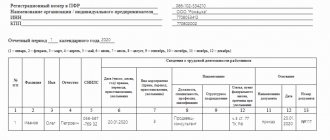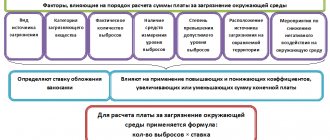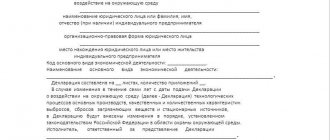The procedure for determining the amount of advances according to the tax assessment
The main document defining the key points of calculation and procedure for making payments for pollution is the Law “On Environmental Protection” dated January 10, 2002 No. 7-FZ.
It provides for the obligation for legal entities that are not classified as small and medium-sized businesses to pay advance payments for negative environmental impact (NEI) during the current year. At the end of the year, the amount of these payments will reduce the total amount of fees accrued for the year in the tax return. Who should pay for the negative impact on the environment in 2020-2021, and who should not, see ConsultantPlus. If you do not have access to the K+ system, get a trial online access for free.
Advance payments are required to be accrued and paid 3 times a year, at the end of the 1st, 2nd and 3rd quarters, before the 20th day of each month occurring after the end of the corresponding quarter (Clause 3, Article 16.4 of Law No. 7-FZ).
How to determine the amount of advance payment? From 2021 there are three such methods. The advance can be determined as:
- ¼ of the fee for the tax assessment payable for the previous year;
- ¼ fee calculated based on the volume or mass of emissions (discharges) of pollutants within the limits of standards, temporarily permitted emissions (discharges) or limits on the disposal of production and consumption waste;
- the product of the payment base, which is determined on the basis of industrial environmental control data on the volume or mass of emissions (discharges) or on the mass of disposed production and consumption waste in the previous quarter, and the corresponding payment rates for environmental waste using the coefficients provided by law.
Reporting on the activities of the enterprise in terms of payment of the tax assessment
Payment for pollution and reporting on how the enterprise’s activities affected the state of the environment and the amount of payments are associated with filling out a declaration, which is an established reporting form. In the current period, those individual entrepreneurs and companies that have permission or a license to conduct activities in pollution zones need to submit information on the NVOS.
Last year, Rosprirodnadzor introduced a new reporting form, according to which reports should be in the established format - you need to fill out the title page, calculate the final payment amount and enter the necessary information in subsequent sections, which in turn are divided into subsections.
In section 1, the final result is payment for emissions from stationary facilities. Subsections correspond to maximum permissible emissions and emissions that quantitatively exceed the limit values. Section 2 corresponds to emissions into water and the NVOS payment for this group. In section 3 you can find the calculation of payment amounts for the impact on natural objects of disposed waste, including subsection 3.1 includes data on municipal solid waste and the corresponding payment amounts.
It is not necessary to fill out all the points - this is only necessary for those sections that have a direct impact on the amounts of the tax assessment.
An example of entering information into a declaration template
Retta LLC is a manufacturer of meat products and natural meat - for this purpose, it uses capacities with a capacity of 50 tons of finished product daily.
This enterprise belongs to objects that have a moderate impact on natural resources. The facility is located in Moscow at the address: 115404, st. XXXX, no. 10, no. 3.
To carry out pollution, the organization is guided by a permit for a period of 5 years and regulatory documents with a similar validity period - this allows it to carry out emissions.
According to 2021 data, the negative impact of the facility corresponded to the following characteristics:
- 2 tons of manganese elements were released into the atmosphere - this is not higher than the maximum permissible size specified in the standards. The rate can be taken from regulatory documents - according to the Decree of the Government of the Russian Federation, payment for NVOS for 1 ton of air pollutant is 5,473.5 rubles.
- The sediment at water treatment plants did not exceed the limit and amounted to 4 tons. Payment for each ton of such pollution is 663 rubles. (rounded value).
Sedimentary elements were placed on a separate site in the Moscow Region at the address: 141613, Klin, st. XXXXXX, no. 55. It has state number NNNN in the register.
In the previous reporting year 2021, Retta LLC invested in improving the environmental component of its activities:
- 1 thousand rub. – expenses incurred by the company to reduce harmful emissions.
- A similar amount was spent to ensure that the enterprise generated less waste.
As for the advance quarterly amounts, they amounted to:
- Regarding emissions into the atmosphere - in the amount of 1,234 rubles (these amounts were paid in quarters 1-3).
- Related to the receipt of waste at specially equipped sites - 234 rubles each in the 1st, 2nd and 3rd quarters.
NVOS form No. 1
NVOS form No. 2
NVOS form No. 3
When do you need to submit a declaration?
The reporting deadline is the same for everyone - information must be submitted to Rosprirodnadzor no later than March 10 of the year following the reporting year. However, in 2021, an exception was made for payers and extended until March 12. This is due to the fact that the reporting date falls on a weekend.
Annual payments are made no later than March 1 following the reporting period. It should be noted that as a general rule, the owner or tenant pays the amount in four installments - three quarterly advances and a final payment at the end of the year.
Only a representative of a small or medium-sized business can make a one-time payment.
Let's look at some of the features that we encounter in the process of generating reporting amounts.
The first feature is that a payment deadline that falls on a weekend or holiday does not mean that you can pay the amount later. In this case, you need to take care of payments in advance. The deadline for transferring advances is no later than the 20th day of the month following the 1st, 2nd and 3rd quarters, in the amount of ¼ of the fee for the previous reporting calendar year. Therefore, in order to obtain information on the amounts of advances made to the tax assessment in 2021, you need to raise the information for 2021.
Below are the quarterly payment terms:
- For the 1st quarter of 2021 - no later than April 20, 2021.
- For the 2nd quarter of 2021, the advance payment is due no later than July 20, 2018.
- Advance amounts of the NVOS for the 3rd quarter of 2021 are transferred to the budget no later than October 19, 2021 (October 20 falls on a Saturday and the law does not provide for transfer to the next working day).
An approved BCC applies for each section of the declaration.
The second feature is related to the period of existence of the company. If in 2021 it was not created or did not carry out economic activities, advances are not paid in 2021 (this applies to entities of different types), and only at the end of the year the overall environmental impact is summed up, according to which the NVOS payment is made.
Example of calculation and payment stages for Lima LLC
According to the data received about the business entity, LLC is not included in the group of medium and small entities. Within the framework of current legislation, Lima LLC must make advances during the year according to the general scheme. To obtain information about payments, you need to refer to the data for the previous year - in 2021, management transferred 60 thousand rubles. Therefore, in 2018, 15 thousand rubles will be transferred to the budget in each quarter.
As for the payment schedule, it is presented above.
At the end of 2021, the company’s employees accrued 65 thousand rubles to pay for the NVOS. Thus, the annual payment must be made no later than the 1st of March 2021. Its size is 20,000 rubles. and this amount is calculated as 65,000 rubles. (which corresponds to the annual tax assessment payment) minus 45,000 rubles. (3 quarterly payments transferred based on information received in the previous reporting year).
What options are there for filing a return?
Reports can be submitted in electronic format using the services of the Rosprirodnadzor portal, or in paper form to those companies and private entrepreneurs that meet the requirements:
- The owner or tenant will not be able to provide an electronic signature.
- The size of the NVOS in the previous reporting year did not exceed 25 thousand rubles.
- The person who makes the payment does not have the technical ability to access the Internet.
On paper, the declaration can be sent by registered mail with an inventory. You can also send the form through a representative.
Along with the paper version, you need to prepare an electronic version - an electronic medium (for example, a flash drive) is enough to submit it. This is due to the operating mechanism of Rosprirodnadzor, which maintains an electronic data register and places only computer files there.
For those who transmit information via electronic channels, there is no need to duplicate the paper version of the declaration.
Instructions for entering data into sections and subsections of the reporting document are contained in the relevant information from Rosprirodnadzor posted on the website. The nature user module is a freely distributed software. All actions can be carried out while in the user’s personal account.
When transferring data, the natural resource user must comply with the required format if he fills out a declaration in third-party software.
What happens in case of delays?
If the data is not received by Rosprirodnadzor on time, officials will be fined 3-6 thousand rubles. For organizations it will range from 20 to 80 thousand rubles.
Territorial divisions request reporting on time
How to calculate fees for 2021
The calculation of the pollution fee for the year is made in the declaration, which includes:
- title page;
- a section with summary results of calculations, in which accrued amounts are reduced due to expenses that reduce the negative effect of polluting impacts, and due to advances paid during the year;
- 3 special sections (according to the number of main types of pollution sources), each of which is a table with the parameters necessary to calculate the payment for the corresponding pollution source, and is filled out only if the payer has such a source.
Calculation in special sections occurs according to the rules described in detail in the order of the Ministry of Natural Resources of Russia dated 01/09/2017 No. 3 (in the notes to the declaration form) and in the Decree of the Government of the Russian Federation dated 03/03/2017 No. 255. Both of these documents also contain the necessary values used in the calculations coefficients
For more information about the parameters involved in the calculations, read the article “Calculation of fees for environmental pollution - 2021 - 2021”.
Pollution fee amount
The environment is affected by different substances. For each of them, a payment base is maintained. The general calculation scheme is as follows: for each unit of the regulatory list, according to hazard and consumption classes, a part of the payment is formed (the rate is taken taking into account decreasing and increasing coefficients).
Payments are calculated as follows: the payment base for each pollutant and waste from those presented in the regulatory list, according to the hazard and consumption class, is multiplied by the rate, taking into account decreasing and increasing factors. The resulting values are summed up to form the final cost of the tax assessment to be accrued. Similar actions are carried out in each reporting period.
Starting from the current year, the NVOS calculation is carried out once during the reporting period.
Thus, the calculation of payment for pollution that enters the environment depends, among other things, on indexation coefficients (see below).
Resolution No. 913 reduced to zero the use of coefficients and standards related to the state of air, water bodies and soil, the special status of objects located in the Far North and regions of similar status. An additional coefficient of 2 has become additional, which indicates the territorial location in specially protected areas (at the federal level).
To calculate NVOS payments, you will need the following data:
- Pollution standards and limits established by official documents of Rosprirodnadzor (care should be taken to ensure that they are relevant on the date of assessment).
- Standard payment rates are approved by the Government of the Russian Federation.
- Coefficients that determine the final result, including in the context of waste disposal, the inflationary component (in fact, it is not currently used, but is present in the indexed rates), increasing rates 5, corresponding to the payment for excess pollution caused to the environment.
- Specific figures for emissions and discharges that distinguish the company’s activities during the reporting period can be obtained in the form of a memo from the authorized departments.
If the owner or tenant has not properly issued permission to operate facilities that negatively impact the natural environment, the waste mass is accepted as exceeding the limit.
Waste accounting is an important element of the enterprise’s activities
For the current period (as well as for others), payment rates in rubles, which compensate for 1 ton of various pollution, are contained in official documents. Depending on the types and types of substances, damage is determined as follows:
Table 2. Payment for environmental damage - individual elements of the list
| Type of pollution | Payment for harmful effects on natural objects, rub./t. (rounded) |
| Atmospheric pollution: 1. Aztn elements. sour. 2. Ammonia pollution. 3. Mercury particles and its compounds (except for the diethylmercury category). 4. Benzopyrene. 5. Elements of hydrogen sulfide. 6. Elements of sulfuric acid. | 1. The rate is 36.6 = 37. 2. The rate is 138.8 = 139. 3. The payment rate is 18,244.1 = 18,244. 4. The rate is 5,472,968.7 = 5,472,969. 5. Payment within the rate per unit 686.2 = 686. 6. Payment of the rate 45.4 = 45. |
| Pollution of water basins and other objects: 1. Aluminum particles. 2. Ammonia pollution. 3. Beryllium. 4. Benzopyrene. | 1. The rate per unit is 18,388.3 = 18,388. 2. Payment per unit is 14,711.7 = 14,712. 3. Payment amount per unit. 1,983,592.8 = 1,983,593. 4. Unit payment rate 73,553,407. |
Disposal of facility activity waste and consumer waste, which differ in hazard classes: 1. Class 1 – this group includes extremely hazardous types of waste pollution. 2. Class 2 is a high-hazard category. 3. Class 3 consists of moderately hazardous substances formed during production and consumption. 4. Class 4 – low-hazard types of pollution. 5. Class 5 – groups of substances that have virtually no effect on natural objects:
| 1. The rate is 4,643.7 = 4,644. 2. The rate payment is 1,990.2 = 1,990. 3. The rate is 1,327. 4. The payment per unit of waste is 663.2 = 663. 5.
|
Let's consider numerical values that can reduce or increase the final cost of monetary compensation for damage to natural objects.
Table 3. Types of impacts with corresponding rates
| Option No. | Numerical values of coefficients | Types of negative influences |
| 1st | No effect = 0 | Waste that is included in hazard class 5 and is deposited in rock voids (this situation is observed in the mining industry) |
| 2nd | 0.3 | This coefficient is applied if hazardous waste is delivered to specially equipped facilities and this placement corresponds to normal values |
| 3rd | 0.33 | If the disposed waste has acquired the penultimate 4th hazard class after neutralization (initial category - 2) |
| 4th | 0.49 | If the disposed waste belongs to the same fourth class after neutralization (initial category - 3) |
| 5th | 0.5 | If the disposed waste of classes 4 and 5 became such as a result of the disposal of harmful substances that were disposed of in previous periods |
| 6th | 0.67 | The indicated rate corresponds to the disposed waste of class 3, which acquired this group after neutralization of waste of the 2nd group of harmful substances |
Payments for environmental damage are divided into 2 types. Basic payments are made within acceptable standards. The second type of payments for environmental pollution is differentiated and depends on the permissible values of the PNOLR.
Payments for pollution of natural objects that are impacted during operation are taken into account in a special waste management register that affects the state of the environment. For large facilities, it is not always easy to determine and calculate payment amounts. Software products make the task easier - in them the user can independently calculate the size of the tax assessment and prepare the required reporting. There are also special online services with which you can determine the amount to be paid.
Modern technologies make it easier to calculate the NVOS
The organization or private entrepreneur makes all calculations independently.
Deadlines for pollution charges
Legal entities obligated to make such payments make advance payments 3 times a year. Calculations for the year are completed with one more payment - payment of the total amount received in the section of the declaration allocated to summary data, as a result of arithmetic operations performed on the amount calculated in special sections.
Thus, there are two types of deadlines for payment.
- For advance payments - in 2021 they will expire on April 20, July 20 and October 20.
IMPORTANT! If the due date for payment for the tax assessment coincides with a weekend, the payment must be transferred the day before, since Law No. 7-FZ does not provide for the transfer of deadlines to the next working day (as in the Tax Code of the Russian Federation).
- For the final payment for the year, the deadline for this period corresponds to March 1 of the year following the reporting year, i.e. payment for 2021 will need to be made no later than 03/01/2021.
ConsultantPlus experts explained what will happen if you don’t pay the fee for the tax assessment on time. Get free demo access to K+ and go to the Ready Solution to find out all the consequences.
Those organizations that are not required to pay advances transfer payments to the NVOS once (at the end of the year), i.e., there is only one deadline for them (March 1).
Overpayments under the Tax Assessment can be offset or refunded. Since 09/07/2019, the procedure for credit/refund has been established by law.
Common to all legal entities, regardless of the scale of their business, is the deadline established for submitting a declaration on the NVOS, which expires on March 10 of the year following the reporting year.
For information on possible ways to submit a declaration on the NEE, read the material “How to submit a declaration on payment for negative environmental impact?”.
How to reflect in accounting the fee for negative environmental impact paid in the current reporting year in the form of advance payments? The answer to this question is in ConsultantPlus. If you do not have access to the K+ system, get a trial online access for free.
When and how to report on the NVOS
The declaration of payment for negative environmental impact is submitted no later than March 10 of the year following the reporting year. Thus, the declaration for 2021 must be submitted no later than March 11, 2021 (March 10, 2021 falls on a Sunday).
The declaration must be submitted via the Internet in the form of an electronic document signed with an electronic signature. If the payment for the previous reporting period did not exceed 25 thousand rubles, you can report on paper. In this case, you need to additionally submit a declaration on electronic media (clause 5 of the procedure for submitting a declaration on payment for environmental assessment, approved by order of the Ministry of Natural Resources of Russia dated 01/09/17 No. 3).
You can submit reports online in one of two ways:
- For the first method, you will need an electronic signature certificate, which can be purchased at one of the accredited certification centers. The certificate holder must generate and sign a declaration, and then independently upload it to the receiving gateway of Rosprirodnadzor.
- The second way is to connect to the reporting system, which will help you fill out the report using all the current parameters, check it and send it to the RPN.
Those who choose the second method will receive two benefits:
- you will not need to independently “knock” on the receiving gateway of the on-load tap-changer, which sometimes works with serious interruptions. Instead, it is enough to send the report once to the server of the electronic document management (EDF) operator, and then the robot itself will upload it to the RPN gateway;
- when submitting through the system, the EDF operator will record the time of loading the report and indicate it in the document that the sender will receive. If a dispute arises about the time of filing a declaration, confirmation from the EDF operator will help prove that the reporting was submitted on time.
Fill out and submit environmental reporting through an EDI operator Submit an application
Where and how to pay advances for NVOS
Regarding the place of payment, the pollution fee is linked as follows (Clause 1, Article 16.4 of Law No. 7-FZ):
- for emissions and discharges it is paid to the budget at the location of the source of pollution;
- for disposed waste it is paid where the waste is disposed of.
That is, OKTMO for payment carried out for different types of polluting objects may turn out to be different. And this must be taken into account not only when drawing up the declaration, but also when making advance payments.
Depending on the type of pollution source, the values of the BCC indicated in the payment document will also differ.
For information on the BCC values used for payments for new environmental impact materials, see the article “BCC for negative environmental impact.”
What distinguishes payments under NVOS from environmental payments?
In addition to payments under the NVOS, there is another payment of an environmental nature, which has the official name “environmental fee”. It is regulated by another regulatory act - the Law “On Industrial and Consumption Waste” dated June 24, 1998 No. 89-FZ.
It has many differences from pollution charges:
- the circle of payers represented by persons producing or importing products that require their disposal upon completion of use;
- tax base, defined as the volume of recycled goods, adjusted to the recycling standard;
- rate depending on the type of product being disposed of;
- the deadline established for payment and being the only one, coincides with the deadline for submitting collection reports and corresponds to the date of April 15 of the year following the reporting one.
The legislation does not provide for advance payment of environmental fees. Thus, there is no need to make advance environmental payments in 2021.
Read more about the environmental fee in the material “Who must pay the environmental fee in 2021 - 2021?”
Results
Advances on payments for NVOS must be paid by legal entities that are not classified as small or medium-sized businesses.
Such payments are made three times a year, upon completion of the 1st, 2nd and 3rd quarters, no later than the 20th day of the month following the end of the corresponding quarter. The amount of each advance is determined in one of three ways specified in Law No. 7-FZ. You can find more complete information on the topic in ConsultantPlus. Free trial access to the system for 2 days.








